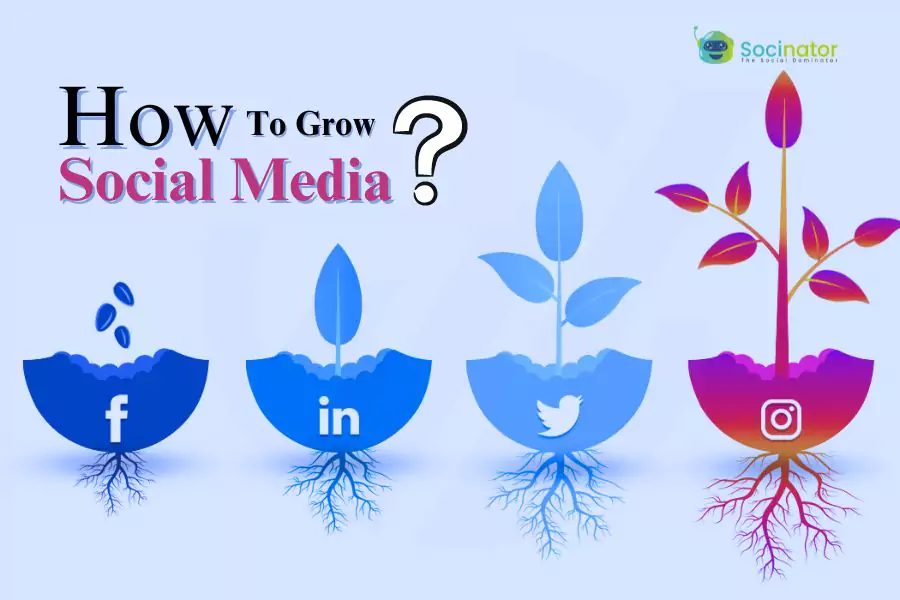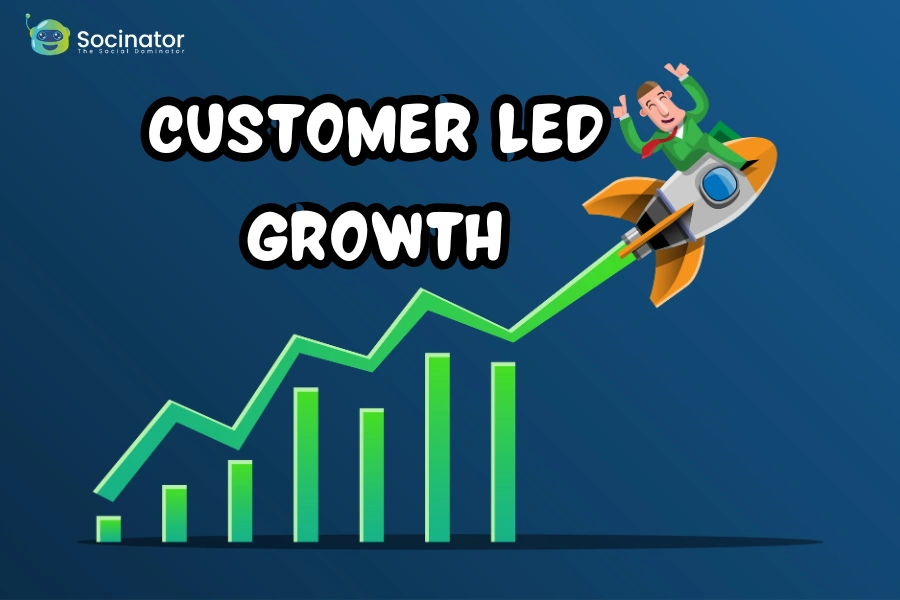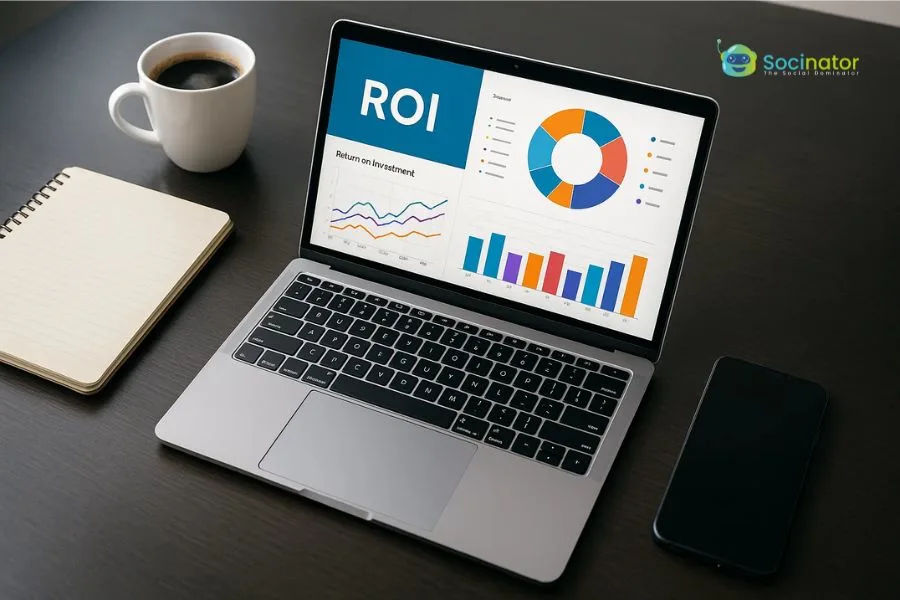A strong social media presence isn’t just advantageous- it’s essential for any business aiming to thrive. Whether you’re just starting out or already established, increasing your followers can greatly- grow social media reach and engagement.
But figuring out how to do it effectively can be overwhelming. This guide is here to help!
We’ll explore easy strategies and expert tips that will- empower your social media and business growth. By the end, you’ll have the know-how to connect with more people online and achieve steady growth for your brand.
Let’s get started!
Hit ‘Play’ Button & Tune Into The Blog!
Why Do Social Media Followers Matter?
Social media followers are the cornerstone of your social media strategy. They engage with your content, share your posts, and amplify your brand’s message. A large and active following boosts brand awareness attracts new customers, and fosters loyalty.
Therefore, it’s crucial to prioritize how you grow social media presence and follow and engage with your audience in your social media marketing efforts.
How To Grow Social Media Followers Organically {6+ Proven Strategies}
1. Run A Contest-
Social media contests are an excellent method to increase your follower count. Typically, the rules are straightforward: participants need to follow your brand and tag friends in the comments to enter. This boosts the contest’s visibility and encourages more followers to participate. Collaborating with influencers or partner brands can further amplify entries and increase visibility.
After the contest ends, there might be some participants who unfollow you. To minimize this, ensure you have engaging and high-quality content ready to maintain their interest and encourage them to remain connected.
2. Share Exclusive Content-
People need a reason to follow brands on social media. It might be a connection to the brand or enjoying its unique voice. Often, followers seek exclusive content, like flash sales with promo codes shared only on social channels. Additionally, social media allows you to display your brand’s more casual, authentic side, which helps grow social media engagement.
3. Collaborate With Relevant Influencers-
Partnering with influencers can boost your brand’s credibility. If followers trust an influencer who endorses your brand, they’re more likely to view your- brand positively. You can collaborate with influencers in various ways, such as account takeovers, exclusive tutorials, or hosting AMAs (#AskMeAnything). Remember, the influencer’s audience alignment with your brand is more important than their follower count. Micro-influencers often have better audience engagement and closer connections with their followers.
4. Create Shareable Content-
Boost your reach by posting content that people want to share within their networks, potentially gaining more followers. Popular types of content include industry news, memes, quotes, and animal photos. Regularly posting shareable content increases the likelihood of followers reposting it on their channels.
5. Utilize The Right Hashtags-
Using highly popular hashtags may not always yield effective results. Niche hashtags can lower competition and enhance the likelihood of your posts being found by potential new followers, thereby helping to grow social media presence. However, avoid overcrowding your posts with hashtags; as excessive usage can decrease engagement and give the impression of spam. Aim to use 11 or fewer hashtags in a post and optimize them in such a way that it would get you more reach.
6. Establish Thought Leadership-
If your founder or leadership team is featured- in the news, it can raise your brand’s profile and attract more followers. Seek out opportunities for webinars, podcasts, and interviews. At the end of these appearances, direct listeners or viewers to your social media channels to learn more.
7. Promote Your Social Media Channels-
Make it effortless for your existing audience and customers to locate you on social media. Incorporate links to your social media profiles in your website footer, embed pertinent tweets in blog posts, and advertise your Instagram contests through email newsletters to grow social media.
By integrating these proven strategies into your social media approach, you can organically grow your follower base while strengthening your brand’s presence and engagement. These efforts not only attract new followers but also build a vibrant social media community around your brand. Remember, consistency and quality are key—keep delivering valuable content and fostering genuine connections to sustain long-term growth on social media
How To Use Social Media To Grow Your Business
Social media marketing, also known as digital marketing, uses various online platforms to connect small businesses with their current and potential customers. It also provides valuable data analytics to help you understand what products, services, or strategies are in demand.
Through social media, you can easily share information with customers, learn about competitors, build brand awareness, make online sales, and grow social media for the long term. Some platforms even pay for engaging content that keeps users on their sites.
Social media metrics can provide important data, such as customer information (emails, phone numbers), audience engagement (likes, comments, shares), referrals, and sales conversions. This feedback helps businesses improve products and marketing strategies. You can also compare your online performance with competitors and make real-time adjustments.
Building Your Brand
Social media reaches a wide audience, making it an excellent platform to showcase your products, services, and brand personality. Your brand identity includes visual elements like symbols, colors, and designs that represent- your business’s mission, vision, and values. The most visible part of your brand identity is your logo, which should stand out from competitors and be easily recognizable.
Also, make sure to mention a slogan or mission statement that communicates your company’s core values and what it stands for. It would help you spread the brand voice with a wide group audience shooting up your brand presence. Brand identity goes beyond packaging; it enables customers to connect with the individuals behind the company and grasp its mission as you grow social media presence.
Popular Social Media Platforms
Here are some prominent platforms, where marketers want to grow their reach with audiences:-
- Facebook: The most popular global platform with nearly 3 billion monthly users. It supports business pages, cross-posts on Instagram, and creates online stores. Facebook groups foster community interactions.
- X (formerly Twitter): Useful for real-time updates and customer engagement with concise information. It offers a paid subscription for greater visibility.
- Instagram: Owned by Meta, it’s designed for photo and video sharing.
- LinkedIn: A professional platform connecting employees with recruiters. It’s great for job ads and creating newsletters.
- Pinterest: A photo-focused search engine popular among women for arts, crafts, and design projects.
- YouTube: Ideal for long-form video content like tutorials, industry explainers, and webinars.
Before committing to a platform, understand its features, costs, and the preferences of your target audience.
Consistent Posting
Consistent posting is key to maximizing your online presence. Utilize a content calendar to plan and schedule consistent posts. More frequent content production helps platforms boost your visibility. When unsure, look at competitors for inspiration. Consider utilizing social media automation tools like Socinator to help manage your accounts and save time. Socinator can assist in scheduling posts, analyzing performance metrics, automating tasks, and maintaining a consistent online presence across multiple platforms efficiently.
Engaging with Customers
To effectively grow social media presence, engaging with customers extends beyond mere content posting. Direct interaction through comments, likes, shares, and messages is crucial. Strategies like hosting live videos, conducting Q&A sessions, and running giveaways can establish personal connections and drive sales. Incorporating chatbots into your accounts can efficiently handle common queries, ensuring sustained user engagement.
Generating Leads
Social media is perfect for finding potential customers. Attract them with unique or informative content and convert them into clients. Leverage social media to experiment with concepts and collect feedback on new products or services.
Paid Advertising
Paid advertising is a powerful tool to expand your reach. Each platform provides various ad options, allowing you to showcase your content directly to your target audience. With a modest investment, you can reach hundreds or even thousands of potential customers.
Ad budgets vary, but even a few dollars per day can significantly impact your reach and sales.
Social media serves as a potent tool for businesses to engage with their audience, cultivate customer relationships, and achieve growth. Additionally, leveraging social media automation tools such as Socinator allows for streamlining tasks and ensuring a consistent online presence across various platforms, aiding in grow your social media presence.
Socinator: Social Media Monitoring Tool
 Socinator is a robust social media automation tool designed to simplify and streamline the management of multiple social media accounts. Automating repetitive tasks helps users save time and grow social media presence. It caters to businesses, marketers, influencers, and individuals looking to expand their reach and engagement on social media without investing significant amounts of time manually- managing their accounts.
Socinator is a robust social media automation tool designed to simplify and streamline the management of multiple social media accounts. Automating repetitive tasks helps users save time and grow social media presence. It caters to businesses, marketers, influencers, and individuals looking to expand their reach and engagement on social media without investing significant amounts of time manually- managing their accounts.
Here’s an overview of what Socinator offers:
- Multi-Platform Support: Socinator supports numerous social media platforms, including Facebook, Instagram, Twitter, LinkedIn, Pinterest, Reddit, Quora, and YouTube. It enables users to manage multiple accounts from a single dashboard.
- Automated Actions: The tool automates a variety of actions, such as liking, following, commenting, posting, and messaging. It helps in maintaining consistent engagement and activity on social media profiles, which is crucial for growth.
- Scheduling: Users can schedule posts in advance, ensuring that content is published- at optimal times for maximum visibility and engagement. This feature also supports bulk scheduling, which is particularly useful for managing content calendars.
- Advanced Analytics: Socinator provides detailed analytics and reports on the performance of social media accounts. These insights help users understand what strategies are working and where there’s room for improvement.
- Smart Publishing: Socinator’s Smart Publishing feature utilizes audience activity and engagement patterns to optimize the timing of posts. By analyzing when your audience is most active and engaged, it ensures that content is published at optimal times. This strategic approach increases the chances of your content being seen and interacted with, thereby maximizing its impact on social media platforms.
- Proxy Support: For users managing multiple accounts, Socinator supports the use of proxies to prevent accounts from being flagged for suspicious activity.
Socinator stands out as a comprehensive social media automation tool that addresses the needs of various users looking to grow social media presence. By automating routine tasks, providing detailed analytics, and supporting multiple platforms, it helps users achieve consistent and scalable growth of social media, making social media marketing more efficient and effective.
How Often Should A Business Post On Social Media?
Determining the optimal posting frequency for your business on social media depends on your specific goals and target audience. Each platform’s algorithm rewards different posting habits, so consistency and audience engagement are key. According to research, here are some recommended posting frequencies:
- Pinterest: 1 post per week
- X (formerly Twitter): 2–3 posts per day; utilize relevant hashtags
- Instagram: 3–5 posts per week, including stories, live videos, reels, and regular posts
- Meta (Facebook): 1–2 posts per day, including live videos and regular posts
- TikTok: 3–5 posts per week
- LinkedIn: 1–2 posts per day
Ultimately, the quality of your content and how well you engage with your audience are more important than the sheer number of posts.
Also Read:
7 Proven Strategies To Build Your Social Media Community
08 Foolproof Strategies To Use Social Media For Small Business
How To Track And Measure Social Media Followers
Tracking and measuring your social media followers is crucial to understanding the effectiveness of your strategy. By monitoring your analytics, you can pinpoint areas for improvement and optimize your efforts for better engagement and grow social media presence.
Here’s how to track and measure your social media followers:
Key Metrics to Monitor
- Follower Count: The total number of followers on each social media platform.
- Engagement Rate: The percentage of followers interacting with your content (likes, comments, shares).
- Reach: The number of unique users who view your content.
- Impressions: The total number of times your content is viewed.
Steps to Track and Measure Effectively
- Set Specific Goals: Define clear, measurable goals for your social media strategy. It will help you focus on the most relevant metrics and assess whether your strategy is effective.
- Use Analytics Tools: Utilize the built-in analytics tools provided by most social media platforms to monitor your performance.
- Analyze Competitors: Examine your competitors’ social media presence for insights. Look at their follower count, engagement rate, and content types to understand what works in your industry.
- Experiment with Content: Test various types of content to discover what appeals most to your audience. Track engagement rates and reach for each content type to determine what’s most effective for your brand.
- Regularly Evaluate and Adjust: Social media trends evolve quickly, so regularly- review your strategy and adjust as needed. Use your metrics to identify areas for improvement and refine your approach for maximum engagement and growth.
By effectively tracking and measuring your social media followers, you can gain valuable insights into your strategy’s success and continuously optimize it for better results.
Wrapping Up
To grow social media business’s followership requires a dedicated approach that blends strategy, creativity, and consistent effort. Tools like Socinator can streamline this process by automating tasks such as scheduling posts, engaging with followers, and analyzing performance metrics.
By understanding your audience, delivering valuable content, and actively engaging with your followers – you can foster a loyal community around your brand.
Remember, building a strong social media presence takes time and patience- but with persistence and a focus on delivering genuine value, you can steadily expand your reach and achieve your business goals. Embrace the evolving landscape of social media, adapt your strategies as needed, and watch as your follower base grows organically, establishing your business as a prominent presence in the digital realm.
FAQs
1. Why is growing social media important for businesses?
Social media enhances brand visibility, fosters customer loyalty through engagement, drives website traffic, facilitates direct customer service interactions, and ultimately boosts sales through effective marketing strategies and relationship-building efforts.
2. What are some effective strategies to grow social media presence?
Create quality content, engage consistently, use relevant hashtags, collaborate with influencers, run contests, optimize profiles, and analyze metrics.
3. How can small businesses grow social media presence on a budget?
Focus on organic methods like regular posting, engagement, user-generated content, and leveraging local communities.
4. Which social media platforms should businesses focus on?
The choice of platform depends on your target audience. However, popular choices include Facebook, Instagram, Twitter, LinkedIn, and TikTok, each catering to different demographics and content types.









